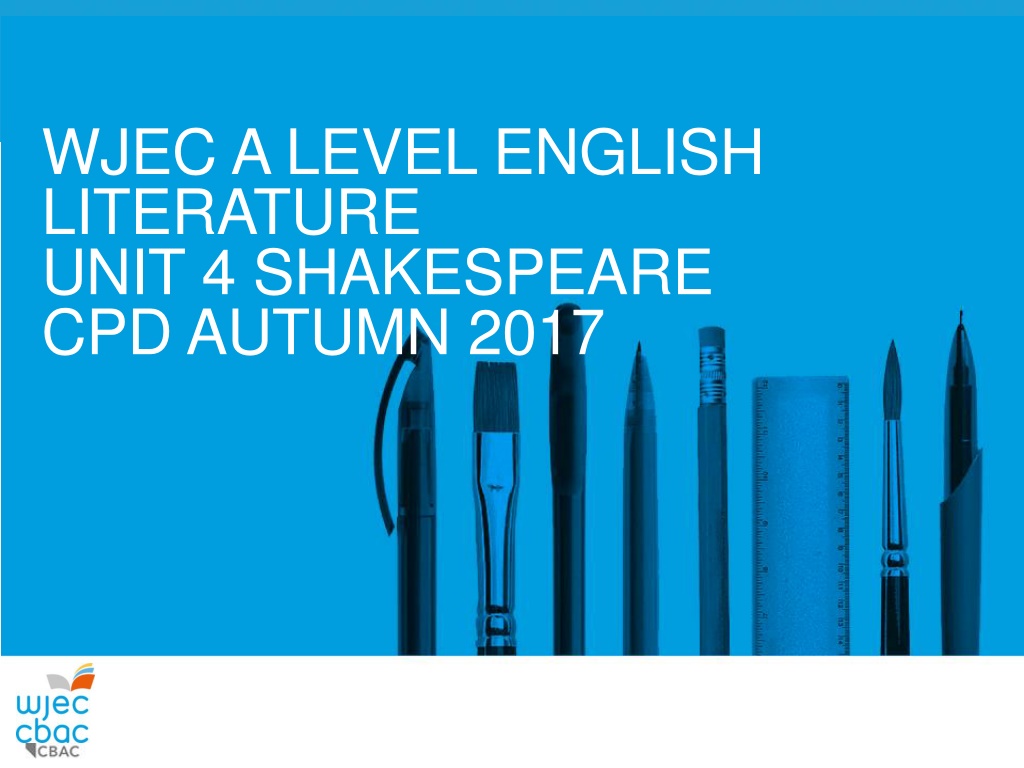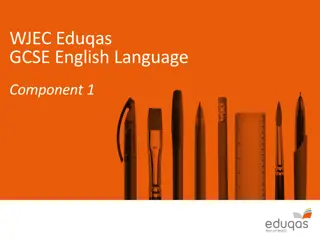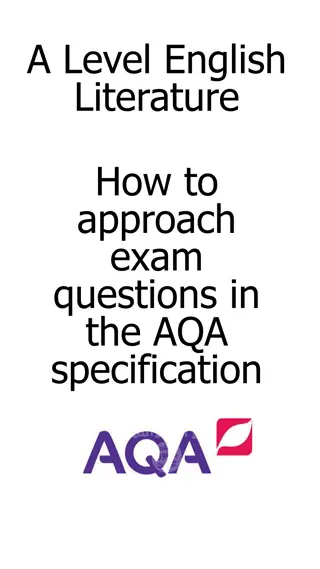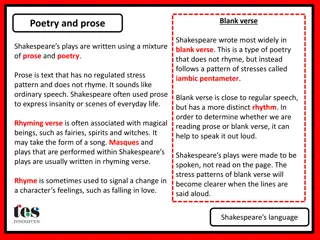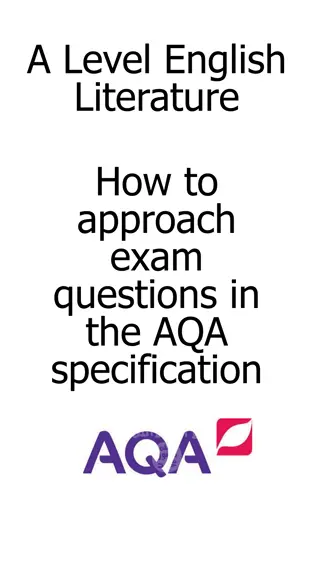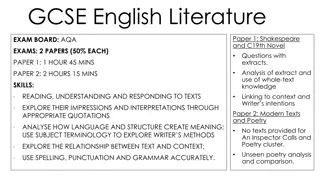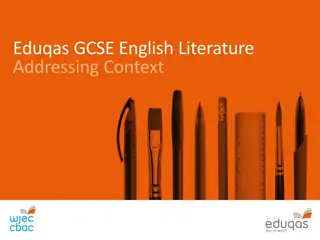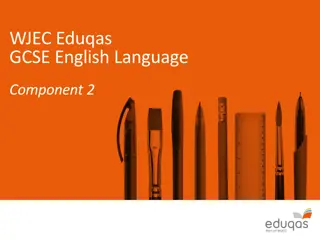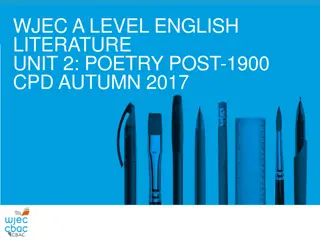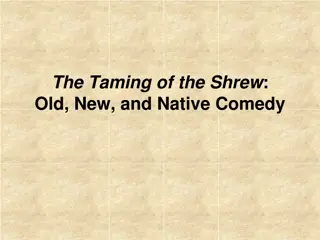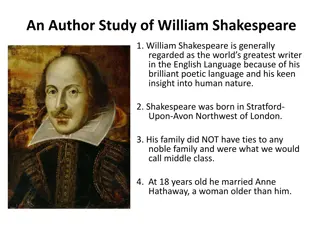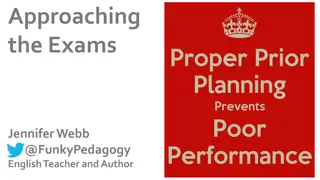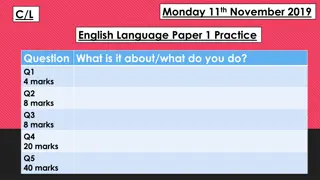Understanding Shakespeare's Extracts for WJEC A-Level English Literature Unit
Explore strategies for analyzing Shakespearean extracts effectively in the WJEC A-Level English Literature Unit, focusing on key points, detailed support, verbatim recall of critical views, and interpreting context. Learn how to prepare and respond to the Shakespeare extract questions, emphasizing character presentation, relationships, attitudes, and dramatic techniques.
Download Presentation

Please find below an Image/Link to download the presentation.
The content on the website is provided AS IS for your information and personal use only. It may not be sold, licensed, or shared on other websites without obtaining consent from the author. Download presentation by click this link. If you encounter any issues during the download, it is possible that the publisher has removed the file from their server.
E N D
Presentation Transcript
WJEC A LEVEL ENGLISH LITERATURE UNIT 4 SHAKESPEARE CPD AUTUMN 2017
Principal Examiners Report: Key Points Positives: an impressive amount of detailed support from and references to the play an equally impressive verbatim recall of critical views, usually put to good purpose considered approaches to integrating context (AO3) and other interpretations (AO5) which enhanced the central arguments in responses evidence that closed book assessment seems to have worked very well; even in Section A, where they have to analyse closely an extract which may appear unfamiliar to them, it was often impossible to tell that candidates didn t have the texts with them.
Section A Shakespeare Extract Preparing to respond 45 marks : AO1 (15) AO2 (30) Timing advice 45 minutes Question only requires focus on the specified point of the play No reward for context and different interpretations Overview of extract : take time to read carefully remind yourself of what the audience sees taking place in the extract at this point in the play now read the extract again until you feel reasonably confident that you understand the speech/speeches next start thinking about what we learn from it in relation to the question
Shakespeare extract It is worth spending ten or more minutes preparing your response in this way before starting to answer the question. Don t start writing immediately, going through the extract line by line : this leads to errors in understanding and irrelevant remarks. If the question asks for a character s thoughts and feelings you must consider both; feelings alone will not suffice.
Shakespeare extract Now select carefully from the extract evidence of how Shakespeare presents a character(s)/relationship/attitudes/thoughts and feelings (depending on the question). Do not track through the extract line by line, commenting as you go along on any device you may spot, as this will result in a less structured and less coherent response. Think about the broader aspects of Shakespeare s presentation, for example if another character in the same extract adds to/filters the presentation of the central character in any way, or use of an aspect of staging/stagecraft. As well as discussing aspects of language and imagery as required by the question, such as metaphorical language, discussing implicit meaning is also important, as this also shows understanding of how language shapes meaning. Remember this is a play, and Shakespeare s dramatic techniques must be considered.
King Lear Extract response In this extract Shakespeare presents Lear as a man on the brink of insanity. The unravelling of his mind is clear in his confusion, nonsense threats and his unpredictable emotions throughout. Towards the end of the extract there is a section where Lear attempts to threaten Regan and her sister with revenges ; however, he says in the same breath what they are yet I know not . By writing these empty threats, Shakespeare is presenting Lear as powerless because suddenly it seems less likely that Lear s revenges will be the terrors of the earth and so his threats mean nothing to Goneril or Regan.
Hamlet Extract response In this extract we see Hamlet caught between action and hesitation, with him initially seeming propelled forwards to take his revenge against Claudius claiming Now I might do it pat. However, Hamlet expresses great uncertainty in the true justice that will be achieved in Claudius death, whilst he is praying. He questions himself, exploring that A villain kills my father; and do this same villain send to Heaven. Shakespeare uses the contrasting ideas of murder and heaven to emphasise that Claudius is unworthy of an afterlife in heaven. This recurrs at the end of the extract with Hamlet defiantly stating that Claudius heels may kick at heaven while his soul is damn d and black as hell . This drives Hamlet s certainty that Claudius does not belong to heaven, therefore he cannot, and shall not, enter. Through mirroring these
The Tempest response- extract During the extract, Prospero decides on exacting forgiveness, instead of retribution, against his adversaries that made him endure intolerable strife. His monologue, spoken in blank verse, illustrates that he is a commanding and formidable presence when possessing his sorcery ability, the so potent art that Shakespeare hyperbolises to accentuate Prospero s authority. Initially, incorporating an imperative tone, Shakespeare presents Prospero as being decisive, instructing his spirit Ariel to go release them , that is the king s company who he has charmed as redemption for their indiscretions. The emotive verb break has connotations to violence, which, highlighted by the inverted syntax in the phrase my charms I ll break , is paradoxical as Prospero is professing that he will not resort to hostilities, but forgive those who did him wrong, their senses I ll restore.
Preparing a response to the Shakespeare extract Read the extract from King Lear, taken from the Eduqas paper (Section A Shakespeare): (handout) ( 15 minutes) Question With close reference to the language and imagery in this extract, examine Shakespeare s presentation of Cordelia at this point in the play. What essential aspects do we learn about Cordelia s presentation here? What do we understand about the situation in this extract? What are the key words and phrases from the extract to help the candidate develop a relevant response to the question?
Section B Shakespeare Essay Points to note 75 marks: AO1 (15) AO2 (15) AO3 (30) AO5 (15) 30 marks for context Timing advice 1 hour 15 minutes Context related material must be integrated and not added in randomly Different interpretations must similarly be embedded into the argument
Unpacking the essay question How far would you agree that Hamlet is not so much a revenge tragedy as a domestic drama? Each question is designed to enable access to AO3 and AO5. Read the question carefully and note the key words/phrases which are intended to encourage discussion of contexts and different interpretations. Plan your approach to the response first, deciding on which areas of the text you will explore in relation to the question.
Unpacking the essay question The contextual focus (AO3) of this question is the play s genre, and so a clear engagement with the significance and influence of the revenge tragedy genre is required, as is an engagement with the concept of domestic drama . As the question asks how far would you agree? candidates can begin to address AO5 (different interpretations). Responses which appear to ignore part of the question, for example only discussing revenge tragedy , are self- penalising.
Example of candidate response to Hamlet essay Q10 Shakespeare s Hamlet in many ways conforms more to the title of domestic drama than the title of revenge tragedy . An emphasis on the destruction of family bonds initiates a focus on domestic life, as seen through the relationships of Claudius and Gertrude and Polonius with his children. The domestic matters of love, heartbreak and madness are also thoroughly explored through the characters of Hamlet and Ophelia. However, it must be remembered that these domestic matters are features of the play within themselves; they largely stem from the desire for revenge that causes Hamlet s noble mind to be o erthrown . Immediately established by Act One of the play is the domestic matter of Claudius and Gertrude s o erhastymarriage .
Unpacking the essay question Unpack the following question on King Lear from Eduqas Component 2 Drama: Consider the view that the conflict between good and evil forces in King Learis shown primarily through Shakespeare s presentation of the female characters. Identify key words/phrases which focus on AO3/AO5 Plan an approach to the question
Examples of integrating context and different interpretations into extended writing tasks for Unit 4 Shakespeare Section B The Tempest 14. The island setting, the use of magic and the supernatural all provide us with nothing more than an entertaining spectacle . How far would you agree with this view of The Tempest?
Candidate response (extract from essay response to Q 14) The tempestuous noise of thunder and lightning that threatens to split the ship carrying the company of Alonso King of Naples acts as a central metaphor for the intrinsic disturbance in the great chain of being , an Elizabethan concept that designated individuals a rooted station in the social hierarchy determined by their lineage. Through pathetic fallacy Shakespeare foreshadows how the great chain of being has been distorted within the context of the play; though a contemporary audience would inextricably associate this tumultuous natural disaster with such a notion, it becomes apparent for any audience via a combination of role reversal and Prospero s substitute exposition.
Candidate response to The Tempest essay continued In conclusion, the island setting, the use of magic and the supernatural do not solely provide the audience with nothing more than an entertaining spectacle . Becoming an allegory for artistic creation, the use of magic, supernatural and the island setting makes The Tempest , in the words of 18th century modernist critic Samuel Taylor Coleridge, a romanticised pastoral poem . The last of Shakespeare s final plays , the ending is despair as Prospero asserts this rough magic I here abjure , halting the spectacle of magic, setting and the supernatural as metaphorically emblematic of Shakespeare retiring his quill.
Final note Candidates and teachers need to remember that above all examiners look to reward engagement with the texts and all discussion of contexts and other interpretations should be properly integrated into the response, not merely acknowledged or invented, as appeared to be the case sometimes.
Cwestiynau? | Any Questions? Cysylltwch n Swyddogion Pwnc arbenigol a th m cefnogaeth weinyddol eich pwnc os oes gennych unrhyw gwestiynau. Contact our specialist Subject Officers and administrative support team for your subject with any queries. gceenglish@wjec.co.uk @wjec_cbac @cbac_wjec cbac.co.uk wjec.co.uk
